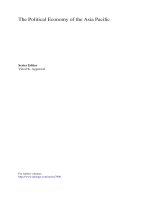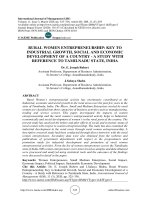Economic growth and economic development 355
Bạn đang xem bản rút gọn của tài liệu. Xem và tải ngay bản đầy đủ của tài liệu tại đây (117.61 KB, 1 trang )
Introduction to Modern Economic Growth
Since the pair (ˆ
x (t) , yˆ (t)) is optimal, we have that
Z ∞
f (t, xˆ (t) , yˆ (t)) dt
V (t0 , xˆ (t0 )) =
t0
Z ∞
≥
f (t, xδ (t) , yδ (t)) dt
t0
t0 +∆t
=
Z
f (t, xδ (t) , yδ (t)) dt + V (t0 + ∆t, xδ (t0 + ∆t)) ,
t0
where the last equality uses the fact that the admissible pair (xδ (t) , yδ (t)) is optimal
starting with state variable xδ (t0 + ∆t) at time t0 + ∆t. Rearranging terms and
dividing by ∆t yields
V (t0 + ∆t, xδ (t0 + ∆t)) − V (t0 , xˆ (t0 ))
≤−
∆t
R t0 +∆t
t0
f (t, xδ (t) , yδ (t)) dt
∆t
for all ∆t ≥ 0.
Now take limits as ∆t → 0 and note that xδ (t0 ) = xˆ (t0 ) and that
R t0 +∆t
f (t, xδ (t) , yδ (t)) dt
= f (t, xδ (t) , yδ (t)) .
lim t0
∆t→0
∆t
Moreover, let T ⊂ R+ be the set of points where the optimal control yˆ (t) is a
continuous function of time. Note that T is a dense subset of R+ since yˆ (t) is a
piecewise continuous function. Let us now take V to be a differentiable function of
time at all t ∈ T , so that
V (t0 + ∆t, xδ (t0 + ∆t)) − V (t0 , xˆ (t0 ))
∂V (t, xδ (t)) ∂V (t, xδ (t))
=
+
x˙ δ (t) ,
∆t→0
∆t
∂t
∂x
∂V (t, xδ (t)) ∂V (t, xδ (t))
=
+
g (t, xδ (t) , yδ (t)) ,
∂t
∂x
lim
where x˙ δ (t) = g (t, xδ (t) , yδ (t)) is the law of motion of the state variable given by
(7.29) together with the control yδ . Putting all these together, we obtain that
f (t0 , xδ (t0 ) , yδ (t0 )) +
∂V (t0 , xδ (t0 )) ∂V (t0 , xδ (t0 ))
+
g (t0 , xδ (t0 ) , yδ (t0 )) ≤ 0
∂t
∂x
for all t0 ∈ T (which correspond to points of continuity of yˆ (t)) and for all admissible
perturbation pairs (xδ (t) , yδ (t)). Moreover, from Theorem 7.10, which applies at
all t0 ∈ T ,
(7.41) f (t0 , xˆ (t0 ) , yˆ (t0 )) +
∂V (t0 , xˆ (t0 )) ∂V (t0 , xˆ (t0 ))
+
g (t0 , xˆ (t0 ) , yˆ (t0 )) = 0.
∂t
∂x
341









